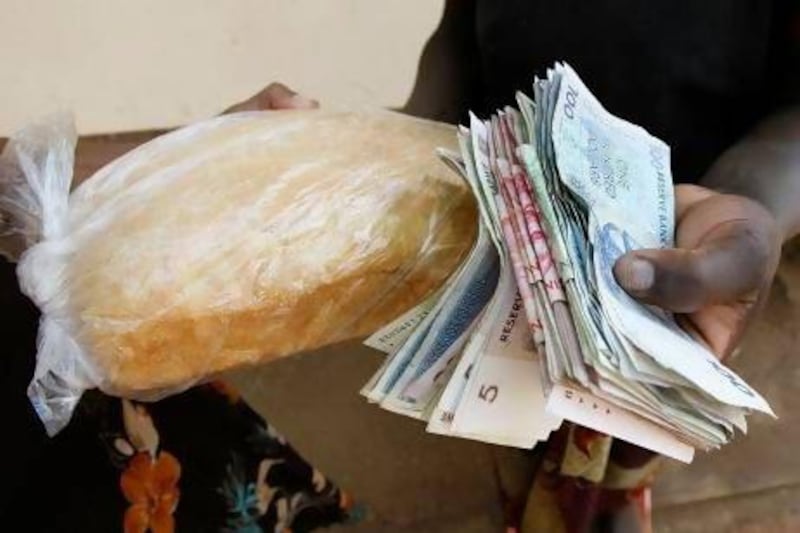Long-suffering Zimbabweans are pretty much resigned to Robert Mugabe romping home to another engineered election victory later this month; but what truly sends a shiver of fear through the streets of Harare is talk of reintroducing the country's currency, the hated Zimbabwe dollar.
Zimbabwe has used the US dollar as its de-facto currency since 2009, not so much by choice as by necessity, after its own paper fiat became virtually worthless after years of dizzying hyperinflation.
However, the 89-year-old Mr Mugabe, who has ruled the southern African country since 1980, told supporters at the ruling Zanu-PF party's kick-off election rally in the capital, Harare, this month: "We cannot use the US dollar forever. We will have to look at ways of bringing back our currency some time in the future."
He speculated that the currency would be backed by gold - hinting that the country's reserves, still mostly unmined and therefore in the ground, would be used to give substance to the Zimbabwe dollar.
His comments caused widespread alarm around the country, where memories of hyperinflation are still fresh. In 2006 Zimbabwe was broke, a result of a policy to force productive white farmers off their land and hand their properties to landless blacks.
Mr Mugabe's government, desperate for cash, particularly to pay off debt and maintain wage payments to civil servants and the army - a vital support constituency - cranked up the printing presses. The result was almost instant hyperinflation.
"If they bring it back I'm leaving," said Margaret Sinclair, an artist living in Harare. "I can't go through hyperinflation again. And everyone I know feels the same way I do. If the Zimdollar comes back, I'm gone."
It is difficult to convey just how much the Zimbabwe dollar is feared and loathed. Officially still the currency, it was essentially abandoned in April 2009, when the reserve bank legalised the US dollar along with other foreign currencies for everyday use.
At the peak of hyperinflation in November 2008, prices rose a difficult-to-conceive 6.5 sextillion per cent in one month. People reacted by creating an alternative economy. Hoarding was the order of the day - when a tin of beans bought in the morning would cost 50 times the price by the afternoon, hanging on to supplies was a prudent strategy.
Trading became essential. "I'd drive to a friend's house to swap a few litres of petrol for bread or milk. Then she'd head off somewhere else to change the petrol for batteries and a chicken," Ms Sinclair said.
So much cash was needed for the smallest of transactions that the Reserve Bank of Zimbabwe could not keep up with demand. Banks began rationing withdrawals, prompting the occasional riot. Travellers' cheques were used as a stand-in for cash and finally, something called a "bearer cheque" was introduced. This was essentially an IOU printed on official RBZ currency paper that could substitute for trillions of dollars, if necessary.
By 2009 it was obvious that the Zimbabwe dollar was doomed, and foreign currency, already trading through a thriving black market, was legalised as tender.
The US dollar is now the currency of choice, and this has stabilised the economy as well as inflation. However, dollarisation has also brought a few problems. The central bank cannot of course print American currency, so Zimbabwe relies on imported notes of which the country never seems to have enough. Notes are often so faded their value is barely visible.
Liquidity is not helped by competition from South Africans, which maintains strict foreign-exchange controls, and where holding any currency other than the rand is illegal. South Africans who want dollars without tipping off the tax authorities are driving across the Zimbabwe border in droves, where they can safely draw the currency from any ATM. Another challenge for Zimbabwe is that US coins are almost entirely absent, making transactions for less than a dollar problematic, and a real issue for a poverty-stricken population that lives off a few dollars a day. Zimbabweans, however, have naturally responded with their customary creativity.
To buy a US 80 cents can of Coca- Cola with a tatty dollar note will result in the 20 cents change being returned in a variety of ways; ballpoint pens, matchboxes, sweets or even a credit note from the cashier. Increasingly though, coins from South Africa are also being used as a stand-in. The rand is currently trading at about 10 to one dollar, which makes one and five-rand coins handy substitutes for US coins. However, the rand is notoriously volatile and a significant strengthening - or weakening - could involve Zimbabweans scrambling for a replacement.
Whatever the difficulties of managing the dollar, Zimbabweans are emphatic that they don't want to see the old Zim dollar return. "Under inflation I used to be a billionaire," a senior Zimbabwean banker told a group of mining investors recently. "Now, with dollarisation, I'm just a millionaire."





